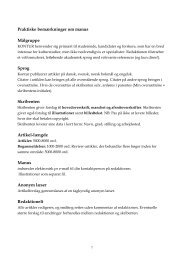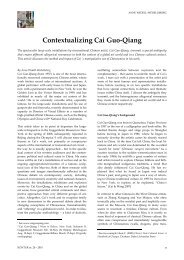Akasegawa Genpei as a Populist Avant-Garde An ... - Kontur
Akasegawa Genpei as a Populist Avant-Garde An ... - Kontur
Akasegawa Genpei as a Populist Avant-Garde An ... - Kontur
Create successful ePaper yourself
Turn your PDF publications into a flip-book with our unique Google optimized e-Paper software.
people in this manner prefigured the loose and<br />
anonymous social networking of the 21st century.<br />
In 1983, when Ak<strong>as</strong>egwa began to write on Tom<strong>as</strong>on<br />
properties in his essay series in the magazine Sh<strong>as</strong>hin<br />
jidai (literally “Photography era”), the reader<br />
mobilization w<strong>as</strong> added to the mix of the collective<br />
activities surrounding Tom<strong>as</strong>on. The mobilization of<br />
students and readers were a logical step for the project,<br />
because to find hidden Tom<strong>as</strong>on properties required a<br />
good deal of walking around on the streets. The more<br />
people participated, the more Tom<strong>as</strong>on properties<br />
would be found.<br />
His serialized essay w<strong>as</strong> first anthologized into a book<br />
in 1985 by Byakuya Shobō, the published of Sh<strong>as</strong>hin<br />
jidai; it w<strong>as</strong> quickly turned into a pocketbook edition by<br />
Chikuma Shobō in 1987. In 1986. <strong>Ak<strong>as</strong>egawa</strong> founded<br />
“Street Observation Society” (Rojō Kansatsu Gakkai)<br />
with the architecture historian Fujimori Terunobu and<br />
others, which represented a peculiar subdiscipline of<br />
modernology (kōgengaku), the study of modern life in<br />
the mold of Kon Wajirō. His Tom<strong>as</strong>on search became an<br />
integral and key component of the society’s activities,<br />
which were then presented at the Venice Architecture<br />
Biennale in 2006, when Fujimori w<strong>as</strong> appointed the<br />
Japanese pavilion’s commissioner.<br />
Crucial in this development w<strong>as</strong> his <strong>as</strong>sociation with<br />
Sh<strong>as</strong>hin jidai/Super Photo Magazine, a photo monthly that<br />
aimed to at once critique the high-mindedness of such<br />
photo journals <strong>as</strong> Camera Mainichi and the proliferation<br />
of binibon, or vinyl-wrapped adult magazines,<br />
commonly sold from vending machines. 17 The star of<br />
this cult magazine w<strong>as</strong> Araki Nobuyoshi, who<br />
maintained three serialized features from its inaugural<br />
issue: “Scenery” (Keshiki), “Girl Friends” (Shōjo<br />
furendo), and “Araki’s Photo Life” (Araki Nobuyoshi<br />
no sh<strong>as</strong>hin seikatsu). During its run from 1981 to 1988,<br />
this subculture magazine enjoyed tremendous<br />
popularity. The inaugural issue in September 1981 sold<br />
140,000 copies, and by 1984, it almost reached the<br />
readership of 300,000 (which w<strong>as</strong> comparable to the<br />
mainstream Asahi Journal). The popularity of Sh<strong>as</strong>hin<br />
jidai w<strong>as</strong> in part informed by the innovative editorial<br />
contents, which included the contributions by<br />
Aksegawa, <strong>as</strong> well <strong>as</strong> such notable writers <strong>as</strong><br />
H<strong>as</strong>himoto Osamu, Minami Shinbō, and Ueno Kōshi.<br />
Like Araki, <strong>Ak<strong>as</strong>egawa</strong> contributed from the first issue<br />
a serialized photo essay under the title of “Unearthed<br />
Photography” [Hakkutsu sh<strong>as</strong>hin], which w<strong>as</strong> changed<br />
17 For the history of Sh<strong>as</strong>hin jidai, see Iida 2002<br />
KONTUR nr. 20 – 2010<br />
REIKO TOMII<br />
to “A Course in Modernology” [Kōgengaku kōza] in July<br />
1984, then to “Tom<strong>as</strong>on Street University” [Tom<strong>as</strong>on rojō<br />
daigaku] in July 1986, and continued through August<br />
1986. Tom<strong>as</strong>on became his topic from January 1983<br />
onward, after he focused on the photos related his<br />
1960s exploits. 18<br />
In writing for Sh<strong>as</strong>hin jidai, <strong>Ak<strong>as</strong>egawa</strong> w<strong>as</strong> highly<br />
conscious of the magazine’s readership who would<br />
likely enjoy semi-pornographic visual contents in a<br />
literally physical manner. 19 By then, his sometimes<br />
abstruse prose style in the 1960s w<strong>as</strong> transformed into a<br />
plainer style, <strong>as</strong> demonstrated by his Akutagawa Prize–<br />
winning novel, Father Disappeared [Chichi ga kieta], in<br />
1980. Still, writing novels that thematize his everyday<br />
life scenes for literary magazines w<strong>as</strong> one thing, writing<br />
for a semi-adult magazine w<strong>as</strong> quite another. Most<br />
noticeably, he devised catchy titles to accompany his<br />
photo essays. Particularly ingenious in his pre-Tom<strong>as</strong>on<br />
installments is “Bodies at Imperial Hotel” [Teikoku<br />
Hoteru no nikutai], whose first page features three fully<br />
naked men showing their backs in the March 1982 issue.<br />
Within the context of nude female bodies graphically<br />
exposed, the solid bottoms of <strong>Ak<strong>as</strong>egawa</strong> and his Hi<br />
Red Center colleagues presents a stunning view.<br />
Furthermore, the use of the word nikutai, instead of the<br />
more abstract shintai carries a certain reference to the<br />
postwar nikutai bungaku (literature of carnal flesh), a<br />
genre of literature known for explosive depictions of<br />
eroticism and decadence. After Tom<strong>as</strong>on became his<br />
topic, his reference to Abe Sada <strong>as</strong> “Tom<strong>as</strong>on’s mother”<br />
in the January 1984 issue is another tour de force: an<br />
inexplicably truncated electric pole reminded him of<br />
the woman who c<strong>as</strong>trated her lover in the prewar<br />
Shōwa (who w<strong>as</strong> the real-life female protagonist of<br />
Ōshima Nagisa’s film, In the Realm of the Senses).<br />
His writing style, too, <strong>as</strong>sumed an incre<strong>as</strong>ingly<br />
colloquial and frank tone, creating a close affinity with<br />
the readers, some of whom would send him their<br />
discoveries of Tom<strong>as</strong>on properties. Through writing for<br />
a subculture magazine, he learned to write for the m<strong>as</strong>s<br />
audience. (The English translation published in 2009<br />
aptly captures the lighthearted character in the original<br />
Japanese.)<br />
His transition from the domain of subculture and<br />
popular culture to that of mainstream culture w<strong>as</strong><br />
helped by his collaboration with the architectural<br />
18 The table of contents for the entire run of Sh<strong>as</strong>hin jidai is<br />
found in ibid.<br />
19 <strong>Ak<strong>as</strong>egawa</strong>, conversation with author, 5 June 2010.<br />
43




